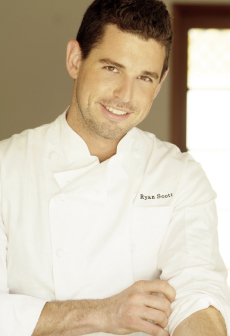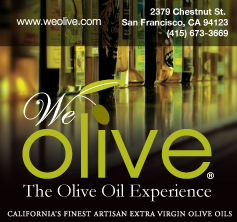
photo: courtesy Ryan Scott
Sautéing is a cooking method similar to stir-frying that uses a small amount of fat in a shallow pan over relatively high heat. Ingredients are usually cut into pieces or thinly sliced to facilitate fast cooking. Food that is sautéed is quickly browned or firmed on the outside, which preserves the texture, moisture and flavor. If meat is sautéed, it is often finished by deglazing (adding liquid to) the pan’s residue to make a sauce. But we’re using the sautéing method for a vegetable, so we’ll deal with sautéing meat in a later lesson.
Grilled Chicken Paillards with Sautéed Kale and Dijon Mustard Sauce
A “paillard” is an older French culinary term that refers to quick cooking a thinly sliced or pounded piece of meat. Most often it refers to veal or chicken (which we’ll be using), but beef can also be used.
Preparing the chicken
8 4-ounce skinless, boneless single chicken breasts
2–3 tablespoons olive oil
Cut each breast lengthwise into three or four strips. Place the strips on a cutting board, and pound with the smooth side of a mallet to ¼-inch thickness. Be sure that the chicken is pounded uniformly to allow for even cooking. Brush each piece with olive oil, cover and refrigerate. Remove 30 minutes before you are ready to grill.
Dijon Mustard Sauce
Next, we’ll prepare our sauce. For a meal like this where the protein is straightforward in its preparation (grilling), the sauce is the key piece that can turn an ordinary dish into something to write home about. It’s not that we want to rely only on our sauces to bring out the brilliance of the food, but a sauce can add a great, quick touch to the overall dish.
2 cups heavy cream
1 tablespoon Worcestershire sauce
2–3 tablespoons Dijon mustard
2 tablespoons minced fresh basil
¼ teaspoon salt
¼ teaspoon freshly ground black pepper
Combine all ingredients in a medium saucepan. Place over medium heat and let simmer for 15–20 minutes, stirring occasionally. Resist the temptation to remove the sauce before it is ready – it should appear thickened. Remove from the heat and whisk for 1–2 minutes, or until it begins to thicken more. Taste and adjust the seasoning if necessary. Set aside and keep warm.
Sautéed Kale
Most people don’t realize it, but there are few foods that have a more impressive nutrient profile than kale. Technically a member of the cabbage family, kale is an excellent source of vitamin C, beta-carotene, chlorophyll, and manganese. It also contains some iron, calcium and potassium. So it’s safe to say that kale resides in that special niche of vegetables aptly titled “superfoods.” I think most people miss out on its nutritional benefits because they’re not exactly sure how to cook it, so they end up writing it off as one of those “weird, green leafy vegetables.”
So here’s an easy way to prepare kale using our Lesson 1 technique of sautéing.
2–3 tablespoons olive oil
1 yellow onion, sliced
1–2 cloves of garlic, minced or finely chopped
1 bunch of kale, washed and chopped into bite-size pieces
Juice of ¼ lemon (about 1 tablespoon)
½ cup of vegetable broth or water
Sea salt and pepper (optional) Warm the olive oil in a large pot or pan over medium heat. Then toss in the onions – they will add some texture to the dish – and stir to incorporate. Cook for 3–5 minutes or until slightly translucent, stirring occasionally so they don’t burn or stick.
Now add the garlic and kale to the onions. Allow it all to cook for one minute, then add the vegetable broth and cover for 4–6 minutes, checking for tenderness at the 4-minute mark. Once the kale is tender, add sea salt and then lemon juice, a few drops at a time. It’s important to taste the kale after each addition of lemon juice to ensure that the whole dish is not soured.
Cooking the chicken
At this point, our meal is almost all done – the chicken has been prepped, the sauce is made, the kale is ready, so all we need to do is a quick grill of the chicken. Grill over a medium flame for 2-3 minutes per side.
Presentation
This is the aspect of cooking most people overlook. I can’t stress this enough, folks: presentation is part of cooking. You’ve worked hard getting the meal ready, so why quit now?
Start by distributing a nice bed of kale evenly across the serving dish, and then arrange the chicken attractively on top. Pour the sauce into a separate serving bowl, so guests can add their preferred amount.
End thoughts
At its most basic, food should be about friends, family and conversation. Does cooking a gourmet meal greatly outweigh chatting with loved ones? Although food is often a focal point at a dinner party, it’s the overall experience that is most valued – the combination of food, ambiance, and company that create an enjoyable environment. In our busy lives, it’s easy to get caught up running from one falling star to the next and to forget which is more meaningful: the constant running, or the things we are running toward?
After stints on Top Chef and at the muchloved, but now-closed Myth Café, Ryan Scott now focuses on his catering company, Ryan Scott 2 Go and can be seen around San Francisco in his food truck, 3-Sum Eats. E-mail: ryan@ryanscott2go.com








